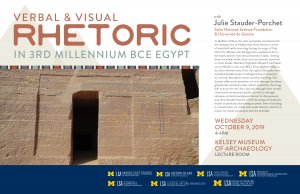Presented By: Department of Middle East Studies
Verbal and Visual Rhetoric in 3rd Millennium BCE Egypt
Julie Stauder-Porchet, Swiss National Science Foundation & Université de Genève

At Qubbet el-Hawa, the elite necropolis associated with the trading town of Elephantine (near Aswan), a series of inscribed tombs were dug during the reign of Pepi II for the officials who led Egyptian expeditions far to the south and the west into present-day Sudan. Among these inscribed tombs, three were extensively inscribed on their facade: Harkhuf, Pepinakht-Heqaib I, and Sabni son of Mekhu (c.2250-2200 BCE). From Qubbet el-Hawa, the place farthest away from the capital Memphis, these inscribed facades project multiples lines of connectivity with the Memphite center, and thus the king. The facades address the passerby, not only through the hieroglyphically inscribed words (which would have been legible only by the very few), but also through their overall visual and monumental quality, as well as through elements in their inscriptional layout. In this presentation, Prof. Stauder-Porchet will be focusing on Harkhuf’s facade in particular, discussing its poetic form (including in visual terms), its verbal and visual rhetoric, and how it makes for visual encounters with the beholder.